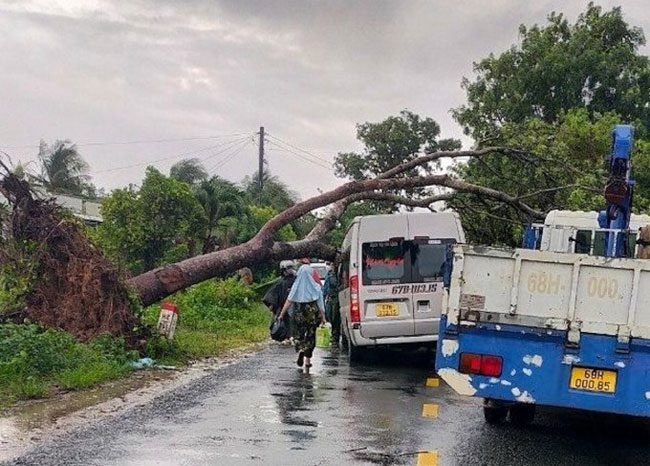The eye of Typhoon Talim acts like a vacuum, intensifying the Southwest monsoon and causing storms in the southern provinces, even though these areas are far from the typhoon’s center, according to weather expert Lê Thị Xuân Lan.
On the afternoon of July 17, when Talim was about 400 km from Móng Cái (Quảng Ninh) – the expected landfall location – heavy rainfall was reported in southern provinces situated over a thousand kilometers away from the typhoon’s center. Gusty winds caused many trees to fall in Ho Chi Minh City, Bình Dương, and Kiên Giang, posing threats to pedestrians. In Đồng Nai, strong winds ripped off tin roofs, damaging a transformer station in the industrial zone, leaving 110 businesses without power. Storms also caused dozens of homes in Hậu Giang and Cà Mau to lose roofs, and fishing boats to sink.

Strong winds caused a 10-meter-high mahogany tree to fall on a 15-seat car traveling on National Highway N1 through Hà Tiên (Kiên Giang) on the afternoon of July 17. (Photo: Phương Vũ)
Explaining this phenomenon, Ms. Lê Thị Xuân Lan (former deputy head of the Forecast Department at the Southern Regional Meteorological and Hydrometeorological Center) stated that typically typhoons entering Vietnam from June to October come from the north to the center. During this time, southern regions are experiencing the rainy season, with strong Southwest winds. Therefore, when a typhoon occurs alongside the monsoon, it brings heavy, persistent rainfall and storms, with wind gusts reaching levels 7-8, comparable to those at the typhoon’s center.
“The eye of the typhoon acts like a vacuum, intensifying the Southwest monsoon,” Ms. Lan explained, noting that the storms seen in the South yesterday were partly due to the tail of Typhoon Talim sweeping through.
Dr. Nguyễn Ngọc Huy, an independent forecasting expert, added that the Southwest monsoon has been active in the region for a long time. When Typhoon Talim formed, it stimulated the Southwest winds even further, carrying moisture from the Gulf of Thailand over the southern provinces to “provide energy for the typhoon.” This is the main reason for the occurrence of storms, lightning, and gusty winds, despite being far from the typhoon’s center.
The tail of Typhoon Talim sweeps and pulls the Southwest monsoon from the Gulf of Thailand, causing storms in the southern provinces. (Photo: Ventusky)
Regarding why the northern and central regions, which are closer to the typhoon’s center, experience less impact, Mr. Lê Đình Quyết (Deputy Head of the Forecast Department at the Southern Regional Meteorological and Hydrometeorological Center) explained that these areas have higher terrain and many mountains that block most of the Southwest winds blowing from the south. Therefore, when Typhoon Talim has not yet made landfall, the wind strength in these two regions is dispersed, insufficient to cause significant storms.
Typhoon Talim formed in the Northwest Pacific, and after entering the East Sea, it primarily moved west-northwest, quickly intensifying to a maximum strength of 133 km/h (Category 12) by July 17. At 12 PM on July 18, the typhoon was located 50 km from Móng Cái (Quảng Ninh), with maximum winds of 88 km/h (Category 9), and it is likely to weaken into a tropical depression within a few hours.




















































